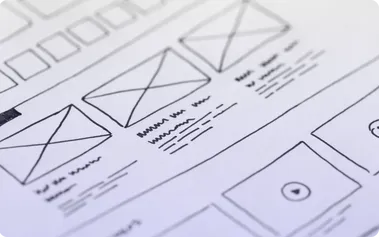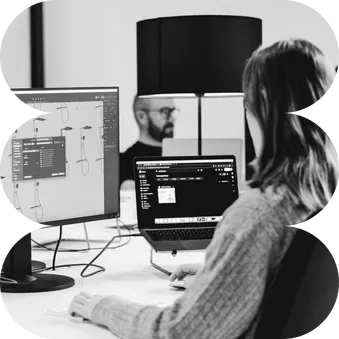UX vs. UI - The crucial differences and similarities
User Experience (UX) and User Interface (UI) Design play a crucial role in the development of digital products and services. Both disciplines are essential in creating a user-friendly experience.

But what exactly lies behind UX and UI Design, and how do they differ? We shed light on the differences and similarities and show how both areas work hand in hand.
What is UX Design? What is UI Design?
Let's start with the basics: UX Design, or User Experience Design, deals with the entire experience a user has with a product. It covers all aspects of interaction, from the first encounter to regular use. The goal is to create a positive, efficient, and satisfying user experience.
UI Design, or User Interface Design, deals with the visual appearance and interactive elements of an application. UI designers work on creating an appealing and consistent user interface that is both aesthetically pleasing and functional.
What do UX Designers do?
1. User Research:
UX Designers start with comprehensive user research to understand the needs and behaviors of the target audience. Techniques such as surveys, interviews, focus groups, and user observations are used. These data help to make informed decisions and design the product in a way that meets the actual needs of the users.
2. Information Architecture:
The Information Architecture deals with structuring and organising content so that users can quickly and easily find what they are looking for. This includes creating sitemaps and navigations that are logical and intuitive. A well-thought-out information architecture is crucial to ensure usability.
3. Wireframing and Prototyping:
UX designers create wireframes and prototypes to develop layouts and interactive models. Wireframes are simple, sketch-like representations of a website or app that show the arrangement of elements and the navigation structure. Prototypes are interactive models that allow testing the user experience before the final development begins.

4. Usability Tests:
Usability tests are crucial for checking a product's user-friendliness. Users test the prototype and provide feedback on their experience. These tests help to identify and rectify potential issues before the product is launched. Through repeated testing and adjustments, the user experience can be continuously improved.
5. Interaction Design:
Interaction design deals with the design of interactions between users and the product. This includes designing workflows, defining user actions, and the system's response to these actions. Good interaction design ensures that users can navigate through the product intuitively.
What do UI Designers do?
1. Visual Design:
UI designers select colours, fonts, layouts, and visual styles that match the brand and create an intuitive user interface. They ensure that the design is consistent and the visual hierarchy is clearly defined. Colours and fonts should reflect the brand identity while also providing a pleasant user experience.
2. Interactive Elements:
Designing buttons, icons, and menus to facilitate pleasant user interaction is another task in UI design. These elements should be easily visible and understandable. UI designers ensure that interactive elements provide appropriate feedback when users interact with them, to ensure a smooth and satisfying experience.
3. Responsive Design:
Responsive design is essential today as users increasingly access applications and websites on mobile devices. UI designers develop flexible layouts that adapt to different screen sizes to ensure a consistent user experience. The design should look and function well across different devices.
4. Design Systems:
UI designers develop styles and guidelines for a consistent and recognizable design. A design system includes a collection of reusable components and patterns, enabling the design team to work more efficiently and ensure design consistency across different products and platforms.

5. Typography:
The selection of the right typefaces and their application in design is crucial for readability and visual appeal. UI designers ensure that the typography matches the brand identity and that the content is easy to read.
6. Graphic Elements:
Icons, images, and other graphic elements significantly contribute to aesthetics and user-friendliness. UI designers select and design these elements in a way that complements the overall design and enhances the user experience.
Differences between UX and UI Design
The main difference between UX and UI design lies in focus and approach:
- UX Design focuses on the entire user experience and on how the user perceives and uses the product. It is analytical and technically oriented, dealing with functionality, usability, and accessibility.
- UI Design, on the other hand, focuses on the visual appearance and interactive elements of the user interface. It is more creative and aesthetic, ensuring a visually appealing and consistent interface that matches the brand identity.
Intersections of UX and UI Design
Although UX and UI design have different emphases, they work closely together and overlap in several areas:
- Prototyping and Testing: Both disciplines are involved in creating and reviewing prototypes. UX designers often test early versions to improve usability, while UI designers ensure that visual and interactive elements function well.
- User-Centered Approach: Both UX and UI designers place the needs and expectations of the users at the center of their work. They collaborate to ensure that the app is both functional and aesthetically pleasing.
- Consistency and Coherence: UX and UI designers work together to create a consistent and coherent user experience. UX designers ensure a logical structure and smooth interactions, while UI designers maintain a uniform visual design.
Impact on the End User
A successful combination of UX and UI leads to high usability and satisfaction. Users can intuitively operate the product and have a positive experience, which leads to higher user engagement. Both UX and UI must consider the needs of all users, including people with disabilities. Accessibility and inclusivity are crucial for wide acceptance and use of a product. An example of accessible design is the website of the Federal Ministry of Labour and Social Affairs. It offers various adaptation options to ensure content is accessible to all users, regardless of their individual needs. For example, some content is prepared in sign language.
By creating a positive and consistent user experience, long-term user engagement can be increased. Satisfied users are more likely to return and recommend the product. An example of this is the loyalty of Apple users. Through continuous innovation and a seamless user experience, Apple has built a loyal user base that keeps coming back to their products.
Trends and Future of UX and UI
Current trends in UX and UI include the increasing use of AI and machine learning, the use of Augmented Reality (AR) and Virtual Reality (VR), as well as a heightened focus on accessibility and inclusivity.

In the future, UX and UI will merge even more closely as new technologies and tools are developed. Innovations such as voice control, gesture control, and personalised experiences will continue to change the way we interact with digital products. An example of future developments is the increasing importance of ethics in the design process. Designers will need to focus more on the social and ecological impacts of their work. This is already evident in initiatives like the Ethical Design Guide, which offers designers guidelines for ethical practices.
Artificial Intelligence (AI) and new technologies are playing an increasingly important role in UX and UI design. They enable personalised and adaptive experiences that are tailored to the individual needs and preferences of users. An example of this is the use of chatbots in customer service. By implementing AI, companies can provide support around the clock while simultaneously improving efficiency.
Conclusion
UX and UI design are both essential for the success of digital products, yet they differ in their approach and focus. While UX design considers the entire user experience, ensuring it is smooth and enjoyable, UI design ensures that the user interface is visually appealing and functional. Both disciplines work closely together to deliver an outstanding final product. Good UX design without appealing UI design will not fully satisfy users, and conversely, a beautiful UI design without good UX cannot create long-term user engagement.


